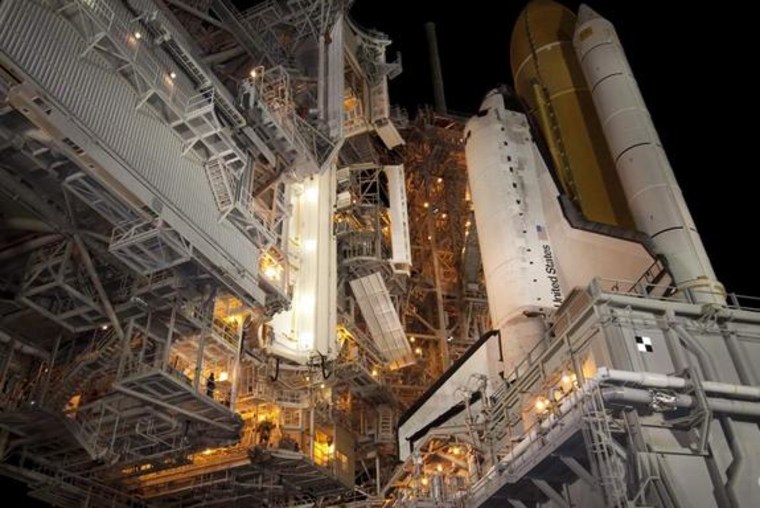NASA officials met Friday to discuss whether to add a bonus photo session to the upcoming flight of space shuttle Discovery, which is set to make its final trip to the International Space Station later this month.
Shuttle program managers talked about the possibility of having the Russian Soyuz capsule undock from the space station and fly around the space station to snap photographs of Discovery while the ship is docked to the completed orbiting lab.
The discussion was part of a program-level flight review to check if Discovery is ready for its final spaceflight. The mission is slated to launch on Feb. 24 and NASA will conduct one last review of Discovery's preparations on Feb. 18 before clearing the shuttle for launch.
No firm decision on the photo opportunity has been made, but "it is being evaluated by all programs involved, including the station partnership," NASA spokesman Kyle Herring told Space.com in an e-mail.
A similar shuttle-space station photo session occurred in 1995 when cosmonauts on a Soyuz photographed Discovery's departure from the Russian space station Mir during NASA's first shuttle flight to that space station. But it has never been performed at the International Space Station.
Program managers at Johnson Space Center in Houston and other NASA centers reviewed Discovery's status, as well as that of its STS-133 astronaut crew and the flight and launch control teams. The meeting ended with a unanimous recommendation to proceed to the agency's readiness review meeting, which is scheduled for Feb. 18.
At NASA's Kennedy Space Center in Cape Canaveral, Fla., engineering teams have completed work to change a hydrogen gas vent seal on Discovery's external fuel tank. Workers at Launch Pad 39A successfully replaced the seal earlier this week, despite dropping a tool during the repair work.
The accident occurred late Tuesday, when a tool known as a feeler gauge, which is made up of 13 thin strips of metal held together by a screw, came apart. No one was injured by the falling metal strips, and shuttle technicians closely inspected Discovery overnight and the next day.
Minor foam damage to the backside of the external tank was identified, but it will not need any repair work, NASA officials said. All components from the dropped gauge were located.
No further work is planned at the launch pad this weekend, NASA officials said.
Back at JSC, STS-133 mission specialists Steve Bowen and Alvin Drew spent the day rehearsing procedures for the mission's first spacewalk in a giant underwater simulation facility called the Neutral Buoyancy Laboratory.
The STS-133 mission will be Discovery's 39th and final flight before the space shuttle fleet is retired. The mission has faced numerous delays, first as the result of a hydrogen gas leak, and later because of cracks that were found on the shuttle's fuel tank. The replacement of the hydrogen vent seal this week was the second time that seal has been replaced since Discovery's first launch attempt was scrubbed in early November.
On the upcoming flight, Discovery will deliver a new storage room and humanoid robot assistant to the International Space Station. The 11-day mission will also include two spacewalks.
NASA plans to fly three remaining shuttle missions (including Discovery's STS-133 flight) before the agency retires its orbiter fleet later this year. The space shuttle Endeavour is scheduled to deliver supplies and a billion-dollar astrophysics experiment to the International Space Station in mid-April.
A third shuttle flight, the STS-135 flight of shuttle Atlantis, is slated to deliver cargo and space parts to the space station in June. While the flight was approved by President Barack Obama and Congress last year, it is still awaiting funding approval from a congressional appropriations committee.
You can follow Space.com Staff Writer Denise Chow on Twitter@denisechow.
